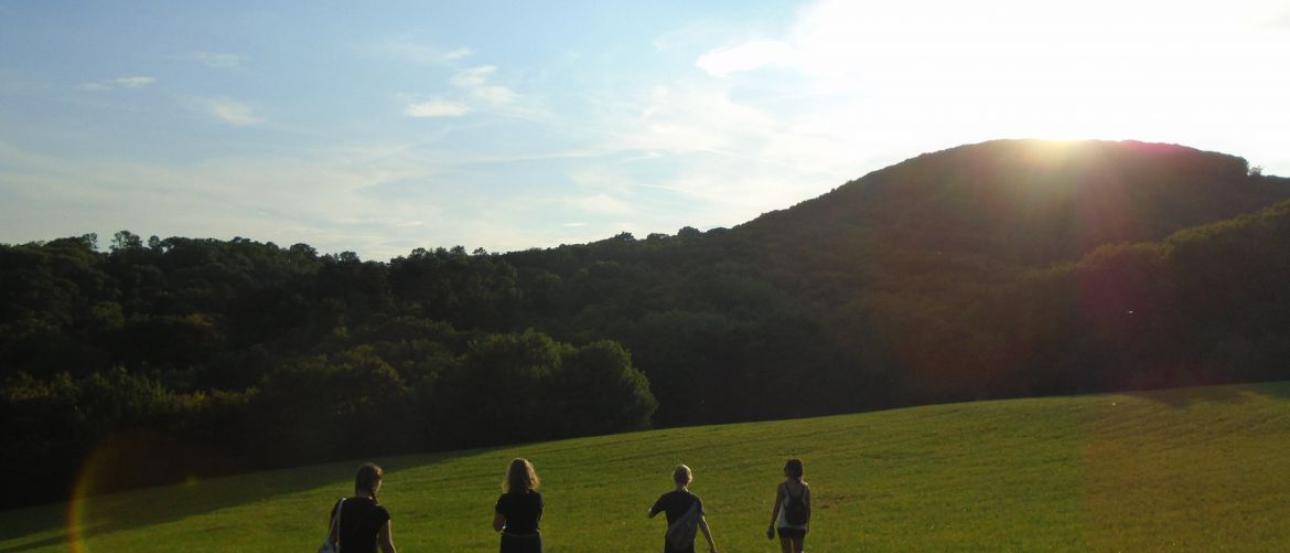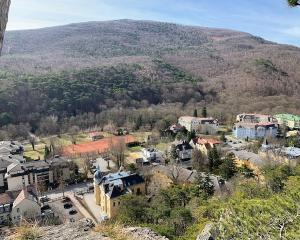The first segment of the circular hike around Vienna, a hike that can start from a number of points depending on one’s enthusiasm for exercise.
Starting Point: The bus stop along the main thoroughfare in Kahlenberger Dorf, which looks onto the Danube, would be a great starting point, as you are within a couple hundred meters of the Nasenweg. Another option is to start walking from the end station of the D tram to Nussdorf, which will add a couple of hours to the hike. Finally, you could go to Grinzing and catch bus 38A, which will take you directly to Leopoldsberg. It is a pleasant ride, and all of it would be included in your transportation pass.
I should mention here that with any of the hikes outside of the borders of Vienna proper, you should buy a Schnellbahn ticket from the Stadtsgrenze, as your Vienna pass is valid up to the city’s boundaries.
Time: Six to seven hours. (NOTE: It is possible to abandon this hike at any point and wander down into one of Vienna’s outlying 17th, 18th, or 19th districts. In other words, this hike could be anywhere from 2-4 hours as well.)
Overview: Just head along the road and look up. You will come to a trail known as “The Nose.” (Nasenweg). It is a very steep path, but well laid out. It has probably been there more than 200 years, as it was constructed by Prince Charles Joseph de Ligne, who was also the source of the famous quote, when asked about how the Congress of Vienna was going, “The Congress isn’t going much, it dances.” (That comes from one of my delightful IES Abroad history lessons in 1981.)
At the top, you will be able to enjoy the views of Vienna and the surrounding areas north and east of the city, the Danube included, from Leopoldsberg. It is not possible to enter the castle any longer, but you can circumnavigate its exterior. Continue on past Kahlenberg, where you can also enjoy the views and stop by the church that Jan Sobieski is said to have prayed in before saving Vienna with his army during the Ottoman siege of 1683.
When looking down upon the rows and rows of vineyards, it should be noted that Vienna is number one in the world for wine grown within its city limits. Other cities may grow more in and around their areas proper, but Vienna ranks one for growing loads of grapes within the city limits. This is a fact to rival the one Lonnie Johnson delivered in his orientation lecture in 1980-81: The Viennese were number one in the world for sugar consumption. (Perhaps he said Austrians; some things are hard to recall after 40 years.)
Continue on for another hour or so, and you will reach Hermannskogel. Climb up to the Habsburgwarte, a delightful little church high above the city. The views are terrific, and this is a good place to sit and have a break. Be forewarned that during the next hour, you will encounter at least three Gasthauser. I am partial to Hauserl am Roan, which features outstanding pork and beef dishes from local suppliers. Oddly, the smoking room has the best views. Remember I mentioned Austrian obstinacy? The modern day Gasthaus has provided a non-smoking area, but often, the back is where you will find it. The front, especially in this establishment, has the better views, the better seats, the better lighting, and the tobacco smoke that many IES Abroad students may look upon as nostalgic from bygone years.
You can choose to end this hike soon by heading down into Neustift am Walde, or you can plunge into some fairly deep woods that will begin taking you out of the city. You will pass fields, meadows, and even a small ski slope with a lift, all of which give you the feeling that you are far, far from the city…when in fact, you are not. Just walk to a bus stop and presto, you will be back at a streetcar appendage that will return you to the city center in due time.
Purkersdorf is a fairly large town if you are able to hike this trail to its terminus (terminus as decided by me). From there, you can catch a Schnellbahn back to the city. It should be noted that the headquarters of the Vienna Woods is located here, not surprisingly, in a very small office on the Hauptplatz.
Variation: Instead of sticking to the red trail away from Kahlenberg, take the alternate trail down to Klosterneuburg. This will take you no more than an hour. The cloister is worth an extensive tour, and actually, joining a proper tour here is a good idea. (It will serve as a delightful brush-up of your German skills.) Signs from Kahlenberg will point you in the direction of the town.
Here I should note that you will want to pick up a Kompass Wander und Bikekarte (Wien und Umgebung). It provides two maps of the city and all of its trails in minute detail. It is indispensable if you don’t want to get lost…and with this, you can be sure that you won’t get lost…not too often, at any rate.






